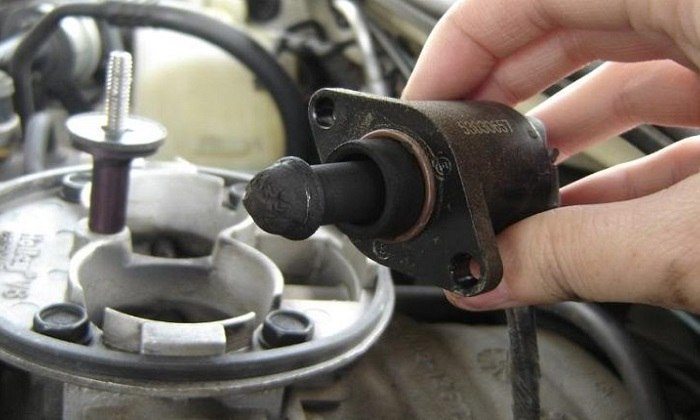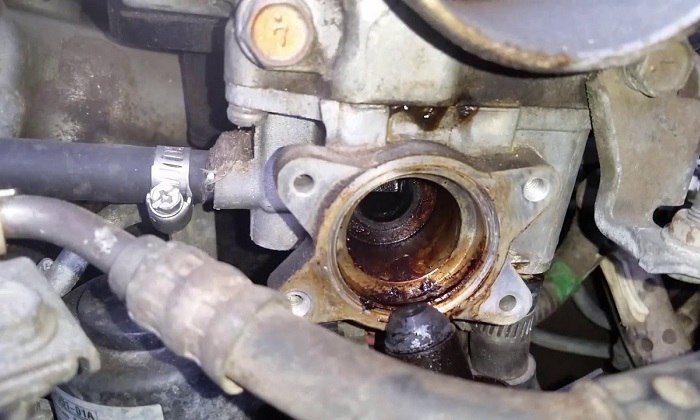by Joshua Thomas
When you have your vehicle's engine running but the car is not moving, the engine goes into idling mode. However, the engine speed or RPM will change depending on the conditions, and the idle air control valve is what controls this idle engine speed.
The idle air control (IAC) valve is a crucial engine management component and it will be connected to the throttle body and managed by the ECU (engine control unit).
Like all other engine parts, it is not fail-proof, and so at some point, it can start developing issues and hence affecting the performance of the engine.
To help you keep this important engine part at the optimal performance level, here we highlight the symptoms you can use to tell when it is going bad or failing and also how to fix it.

With all vehicle problems, the first step in dealing with the issue is always knowing how to diagnose it. Luckily, IAC valve failure should be quite an easy problem to diagnose as it comes with several signs and symptoms.
While the check engine light can sometimes turn on when your vehicle as no issues at all, this is very rare and it mostly happens when the computer also has issues.
Hence, when you see that light, you can be sure there is a problem, and one of the probable problems or issues is a bad idle control valve.
If the ECU notices peculiar or odd revolutions per minute when the engine is idling, it will switch on the check engine light.
And in case you are still not sure that the IAC valve is what is causing the engine light to come on, this combined with one or more of the other symptoms below should remove any doubts.
Because the IAC valve is tasked with idle speed management, if it is not working well, you are likely to get intermittent or randomly fluctuating idle speed as it will not do the job well.
Your idling speed will be all over the place and can be upwards of 1,000 RPM in one minute and under 900 RPM in the next minute. This fluctuation can keep happening for the entire duration the engine is left idle, and besides being annoying, it can easily trigger other engine problems.
Hence, when you notice that the idle speed keeps going up and coming down, you can be sure there is an issue with the IAC valve and need to have it checked by a professional.
For the older vehicle models, the ECU will not be able to compensate for any issues with the IAC valve. And so if your engine has a bad one, you can expect to have a rougher engine idling, which is a good sign that you need to have the valve checked and replaced.
Vehicles with a good or at least normal IAC valve will always have a smooth idling which then also makes starts gentle and equally smooth. If this is not what you get and things are instead rough, then you have a problematic valve.
Also, the bad IAC valve will often result in intense vibrations that come with the rough idling, and the car can react by shaking profusely since the engine is not getting enough air when idling.
An engine stall can be a result of anything from a dirty fuel injector to a loose battery connection. But now you can also add a bad idle air control valve to some of the things that can cause an engine stall.
The issue will mostly stem from the fact that the engine will not be getting enough air when idling, which then can trigger other issues that affect the overall performance and hence causing an engine stall.
Also, it can happen because the ECU is not able to compensate for the issues caused by the bad IAC valve, which in the long run causes the engine to stall.
But, at first, the stall will be occasional, which means you will still be able to use the vehicle. However, if the problem is not checked, the engine stalls become more frequent.
Vehicle backfiring can also be a symptom of a bad idle air control valve. But, it is important to note that just like the four other symptoms above, it can be a sign of other engine issues.
However, if your vehicle jerks as it decelerates when you remove the foot from the gas pedal and you can see excessive fuel dripping through the tailpipe, you can almost be certain that you have an issue with the IAC valve.

With the symptoms explained above in mind, it should be easy to tell when your IAC valve is failing. But, diagnosing the problem is just the first step as you will still need to fix it.
Luckily, it is a fairly easy problem to solve for anyone with moderate mechanic skills, and below we explain the steps to follow.
Directions
One of those steps that many motorists tend to overlook when it is time to work on their vehicle is finding a good place to work from. Nevertheless, this is still a crucial step and should be the first when trying to fix your IAC valve, and a well-lighted garage is one of the best places.
And once you have the vehicle in a safe and secure place with adequate space and lighting, the other preliminary step is to switch off the engine and allow it to cool down. Also, remember to disconnect the battery before you start working.
Bad IAC valve is a broad term, and so before you can fix the problem, you first need to identify the exact issues with it. And this means inspecting and checking it thoroughly. There are different methods to do this.
Method 1: USE OBD 2 Scanner
The first method of inspecting the IAC valve will involve scanning it with an OBD 2 scanner. The scanner will be able to identify and display the specific error codes, and hence allow you to know the exact problem and determine how best to fix the issue.
Method 2: Check the RPM
Checking the RPM is a highly useful method of not only determining whether the IAC valve is working okay but also the probable issues it might have if any.
To check the RPM you will first need to establish the RPM for your vehicle when the idle control motor is disconnected and then compare this with what you get when it is connected.
Once you have established the specific problem with the IAC valve control valve, now you can start the fix. Here the first step will be to remove it and to do this, you will first need to locate it.
For most vehicles, this valve will be located close to the throttle body and in the manifold intake. You can check your vehicle's manual if you are not sure what it looks like.
To remove it, you first need to unclip or unscrew everything that attaches the valve to the intake manifold. But, the process should always start by disconnecting the battery terminal to ensure safe operation.
Next is the actual fix, and here the first option will be to clean up the IAC valve because in some instances debris and carbon buildup is often the only problem preventing it from working optimally.
The cleaning process is also quite straightforward as you will only need to spray with a cleaner and make sure you remove as much debris and dirt as possible before wiping it down with a clean cloth.
Also, remember to clean the throttle body to ensure any debris in there is not transferred to the valve once you put it back in place and drain any excess liquid after this.
Once you are satisfied that the valve is clean enough, you should assemble everything and restore it to its original position, and it should now work fine.
While a thorough cleanup often works well enough in many instances, sometimes the IAC valve can be beyond repair, and so the only option you have in such cases is a complete replacement.
If you prefer a complete replacement, the process is still the same as when you are cleaning it as you will only need to remove the old one and put in the new ones.
But, it is important to make sure that you reattach the throttle body screws securely and that you are using the right replacement IAC valve for your specific vehicle model.
If you are not sure how to do all this, you should not take chances with it and are better off taking the vehicle to a professional mechanic. And also remember to give the vehicle an engine idling test after driving for a few minutes to check if the new IAC valves work well.
Although then idle air control valve might not look like the most important part of your engine, it still plays a crucial role, and so you need to ensure it works well.
A bad IAC valve can come with serious consequences such as engine stalling and can also leave you with an annoying check engine light that will not go off until you have the problem fixed.
But because you now have an idea of some of the symptoms of a bad IAC valve to watch out for and know some of the possible fixes that you can use, this should now be a simple problem to diagnose and fix even without professional help.
Source
 |
 |
 |
 |

About Joshua Thomas
Joshua Thomas just simply loves cars and willing to work on them whenever there's chance... sometimes for free.
He started CarCareTotal back in 2017 from the advices of total strangers who witnessed his amazing skills in car repairs here and there.
His goal with this creation is to help car owners better learn how to maintain and repair their cars; as such, the site would cover alot of areas: troubleshooting, product recommendations, tips & tricks.
Joshua received Bachelor of Science in Mechanical Engineering at San Diego State University.